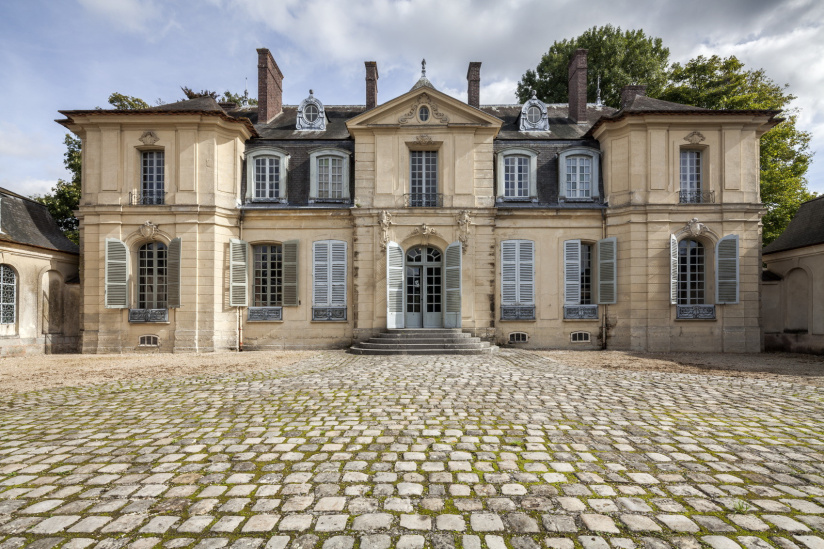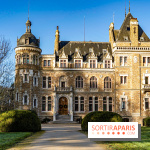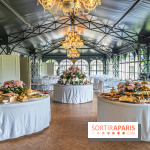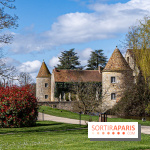Fancy a stroll throughFrench history? Come and discover the great castles of the Ile-de-France region. Their stones conceal secrets that are open to the curious.
The Château de Versailles is one of the symbols of the absolute power of the Kings of France. We'll never tire of strolling through this universe imagined by Louis XIV to showcase his power to the whole world! And every weekend, the 55 fountains located in the 850 hectares of Versailles gardens offer an incredible spectacle, inherited from the Siècle Soleil!
Built in the 12th century by King Louis VI le Gros, the Château de Saint Germain en Laye was originally a fortress on a high site, safe from attack. While kings used it as a château de plaisance, Saint Germain became the favorite residence of King François I, who had the fortress transformed in Renaissance style. The magnificent monument now houses the Musée d'Archéologie Nationale, and brings together masterpieces of Celtic and Gallo-Roman antiquity - 3 million objects, including 29,000 on display - from the Paleolithic to the early Middle Ages.
The Château de Rambouillet, originally a medieval fortress, has seen princes and kings come and go over the years, coming to rest 45km from Paris. Over time, the fort was transformed into a royal pleasure estate, with places dedicated to the leisure activities of queens and princesses, such as Queen Marie-Antoinette's Dairy and the Princesse de Lamballe's Seashell Chaumière - remarkable places to discover!
Did you know that the Louvre was the first residence of the Kings of France? In 1190, King Philippe-Auguste commissioned the creation of a fortified castle to protect Paris. At the time, the castle consisted of a square fortress (78 m by 72 m), surrounded by a moat some ten meters wide. Later, the château was enlarged by its successors, who turned it into a less militarized royal residence. Saint Louis (1226-1270) had a large pillared hall built in the château's basement. François I (1494-1547) decided to demolish the Louvre Palace and rebuild it in the Renaissance style. The Château was occupied by kings until 1681, when the Château de Versailles was built. Traces of the château can still be found in the basement of the Musée du Louvre, and the footsteps of the kings can still be felt in the halls of the Louvre.
Known as a royal residence from the 14th century, the château was used as a prison from the 16th to the 19th century: Fouquet, the Marquis de Sade and Mirabeau were all detained here. Transformed into barracks by Napoleon I, the fortress was intended to protect Paris, and is still home to the Service historique de la Défense. Today, you can still visit the King's apartments, the Sainte-Chapelle and even the upper sections of the Donjon!
The Château de Champs-sur-Marne is typical of 18th-century country houses. Built in 1708 at the request of Louis XIV's financier, it features sumptuous rocaille decorations, as well as chinoiseries painted in the mid-18th century by Christophe Huet. Around it, 85 hectares of gardens lead down to the Marne, via a 900-meter-long path punctuated by copses, ponds, sculptures and wilder, more natural areas. And as a little curiosity, a Briard farmhouse adjoining the château still features a cheese dairy in its original state, with period utensils demonstrating the Brie cheese-making process.
The Château de Fontainebleau is the only royal and imperial château to have been inhabited for 7 centuries. It comprises over 1,500 rooms, with 130 hectares of parkland, and has remained unchanged since the reign of Napoleon III, whose grand apartments can still be seen today. To visit Fontainebleau is to benefit from an exceptional presentation of French history, art and architecture.
The little-known Château de Blandy-les-Tours, located in the very center of a picturesque village in the Seine-et-Marne region, boasts a rich heritage that has spanned history, wars and centuries. A true medieval fortress that has been preserved to the present day, it is one of the most impressive castles in the Île-de-France region. We take you on a voyage of discovery.
Château de Bévilliers is first mentioned in 1560, as a manor house, but the Château de Breteuil as we know it (renamed by the de Breteuil family when it was purchased), came into being in 1830. Two wings were added to the château, and the formal garden was restored. Today, Château de Breteuil is home to a fine collection of scenes from Charles Perrault's fairy tales, including Peau d'âne, Little Red Riding Hood, Puss in Boots...
Château Saint-Jean de Beauregard is a fine example of the art of living in the Grand Siècle... Its name comes from its architecture, which lets the garden into the château, offering a beautiful panorama of the 2-hectare flower gardens. What makes it so special is that the château is still inhabited, but is open to visitors, as are its flowering kitchen garden, stables and dovecote.
The fortified town of Dourdan is one of the best-preserved medieval remains in the Ile de France region. Completed around 1222 by King Philippe Auguste, the fortified castle has preserved most of its innovative defensive structures for the period: dry ditches, curtain walls, towers and entrance châtelet.
Château d'Auvers-sur-Oise was built around 1635 by Zanobi Lioni, a wealthy Italian financier in the entourage of Marie de Médicis. In 1662, the château was sold to Jean de Léry, President-Treasurer of France, who transformed the residence into a French château. Since then, the Château has been converted into an Impressionist museum, leaving little room for its original architecture in the interior rooms, but it's still a pleasure to enjoy the 8-hectare park and three gardens: the Italian Renaissance garden, the French garden and the English garden.
Château d'Ecouen is a Renaissance château built in the 16th century for Anne de Montmorency. For his residence, the Constable thought big and hired the best craftsmen of his time, who incorporated the finest innovations of their era: paving, stained glass, panelling, painted friezes and landscapes, marble... Today, the Château d'Ecouen houses a Renaissance Museum, whose works come mainly from the Musée de Cluny (Paris). Note the splendid David and Bathsheba tapestry, with its constraining dimensions of 75 m long by 4.50 m high, and one of the very first copies of Leonardo da Vinci's famous Last Supper, commissioned from Marco d'Oggiono in Milan in 1506.
The history of Villarceaux begins in the 11th century, when Louis VII founded a Benedictine priory for women, who lived in near-autarchy. In the 15th century, the site was chosen for the construction of a fortified castle to protect the Kingdom of France. Over time, the fortress was developed, and today there are two castles, a golf course, accommodation in the renovatedformer sheepfold and a farm with arable land.
Château de Roche Guyon dates back to the Middle Ages, with a wall bounded by 4 towers, including a 38-meter-high tower, surrounding a square courtyard and a keep. During the Renaissance, the château was enlarged with a main building and several terraces supported by arcades. In 1741, a vegetable garden bordering the Seine was added to the château de Roche Guyon, making it a charming spot appreciated by the Impressionists. Today, the château's guardroom, billiard room, petit salon and magnificent library have all been restored to their 18th-century glory.
Château de Jossigny is a rocaille-style residence built in 1753 by Jacques Hardouin-Mansart and decorated by rocaille ornemanist Nicolas Pineau. The 2,500m² building comprises a main dwelling and two side pavilions for the chapel and kitchen. The courtyard is flanked on either side by an orangery on the right, to the south, and stables on the left... Although the Château still exists, it is closed to the public (except on rare occasions). The Centre des Monuments Nationaux has launched a call for projects to enhance the château and open it to the public in the coming years.




Château de Maisons is a beautiful residence on the edge of the forest of Saint-Germain en Laye. It was conceived by Jean René de Longueil in a strategic location, precisely on the path leading the king from the Château du Louvre to the Château de Saint-Germain en Laye. The idea was ingenious: to meet the king by offering him a short break during his journey. The nobleman called on Mansart to design the château:he even went so far as to reserve a wing of the building for the monarch, with theKing's Apartment featuring a room with an imbricated domed ceiling and a ballroom designed for the Sun King. With this strategy, Jean René de Longueil hoped to attract the king's good graces, and the king came to stay for a night in 1671!
Discover the Château de Monte-Cristo, the residence imagined by the writer Alexandre Dumas. Set in an English garden in the heart of the Yvelines, on the Saint-Germain-en-Laye side, you'll find an exuberantly styled 19th-century château and its small Château d'If. We take you on a tour of this hidden heritage, listed as a historic monument.
The Château de Malmaison, located in Rueil-Malmaison in the Hauts-de-Seine region of France, is now home to the Napoleonic National Museum. During the French Revolution, Josephine Bonaparte acquired the property and it became the Palais Impérial de Malmaison, transforming it into the seat of government for a time.
The Domaine de Chantilly has existed since the Middle Ages, but it was during the Renaissance that Anne de Montmorency decided to have a château de plaisancebuilt in the French Renaissance style by the architect Jean Bullant. In the 17th century, Louis II de Bourbon invited great artists such as Molière, Racine, La Bruyère and La Fontaine. In 1719, Louis-Henri, Duc de Bourbon, enlarged the estate with the Grandes Écuries, and in 1740, Louis-Joseph continued his father's work with the construction of the Hameau, the theater and the Jeu de Paume. Unfortunately, the Grand Château was demolished during the French Revolution, but rebuilt in 1875 by the Duc d'Aumale. Since 1898, the estate has been open to the general public, showcasing all the Duc d'Aumale's collections.
The Domaine de Compiègne was bought by Charles V to build a fortified castle. The building retained its medieval appearance until Louis XV decided to restore the château of his ancestors. He called on the architect Ange-Jacques Gabriel, but died before the work was completed. Louis XVI took an interest in the estate and continued the renovation work with the creation of the new wing overlooking the park, while Marie-Antoinette carried out major interior refurbishments, including theking's and queen'sapartments. The Château was refurbished under Napoleon I and then Napoleon III, and the decorations are still visible today.
Château de Pierrefonds, a jewel of medieval architecture, is located in the Oise region, just an hour from Paris. Built in the 14th century by Louis d'Orléans, it was restored in the 19th century by the architect Eugène Viollet-le-Duc, who gave it back its majestic allure. A visit to the château reveals richly decorated rooms, monumental fireplaces and colorful frescoes. The surrounding gardens offer panoramic views of the Compiègne forest.
The Château de Chambord was built at the request of François I in 1519, at a time when France was in the throes of political, intellectual, artistic and philosophical ferment. The Château was intended to be the architectural jewel of France, a symbol of power to be shown to the world even before Versailles. The centerpiece of the Château is the famous double-revolving staircase, inspired by Leonardo da Vinci, which ensures that those ascending never pass those descending. A masterpiece! You can also enjoy the gardens(French and Englishgardens ) and the Cosson, the river that runs alongside the Château.
Château de Cheverny is one of the best-known Châteaux in the Loire Valley. Built in 1624, the Château has retained its classical style. The apartments on the 1st floor bear witness to the art of French living: the Birth Chamber, the King's Room, the Arms Room and the private dining room... The park of almost 100 hectares includes a kitchen garden, an apprentice garden, a tulip garden (to be admired in March and April) and a labyrinth.
The Château de Chenonceau is known as the Château des Dames. Bought by François I in 1535, it was given as a gift to Diane de Poitiers, the favorite of King Henri II. In 1559, Catherine de Médicis (Henri II's widow) reclaimed the château and installed the young king in Chenonceau, along with Italian splendor. Catherine de Médicis turned the château into a veritable Venetian palace, a "Ponte Vecchio" in Touraine. Today, you can still visit the salons of François 1er and Louis XIV, the bedrooms of Diane de Poitiers and Catherine de Médicis, and dozens of paintings by Rubens, Primaticcio, Tintoretto, Correggio, Van Loo, Murillo, Clouet, Sassoferrato, Andrea del Sarto, Ribalta, Nattier, Veronese, Poussin, Van Dyck...
Just a stone's throw from Giverny, Château de Bonnemare is a beautiful 16th-century Renaissance château that's well worth a visit in summer. Château, farmyard, chapel, stables and cider house (Normandy obliges) have indeed stood the test of time and offer an authentic setting to be discovered on special occasions, such as vacations and Heritage Days.



 Discover the Royal Sunday Brunch at Château de Méridon in the Chevreuse Valley
Discover the Royal Sunday Brunch at Château de Méridon in the Chevreuse Valley
How about a royal brunch at Château de Méridon? Between Cernay la Ville and the Château de Breteuil, you can enjoy a dominival brunch in an exceptional green setting. [Read more]



 Royal all-you-can-eat lobster brunch at Château d'Hardricourt in Yvelines, France
Royal all-you-can-eat lobster brunch at Château d'Hardricourt in Yvelines, France
The Château d'Hardricourt, in the Yvelines department, unveils its lobster brunch every Sunday. How about an all-you-can-eat brunch with lobster and champagne, all in the château's magnificent garden? [Read more]



 An exceptional brunch at Château de Villiers-Le-Mahieu in the Yvelines, with all kinds of entertainment
An exceptional brunch at Château de Villiers-Le-Mahieu in the Yvelines, with all kinds of entertainment
If you'd like to go green and enjoy an exceptional all-you-can-eat brunch without having to go to the ends of the earth, then we invite you to discover Château de Villiers-le-Mahieu in the Yvelines. Part of the Les Maison de Campagne group, this site also offers a whole range of activities included in the package, for a fantastic day out. Golf, boating, cycling, games, cinema and even snacks await you... [Read more]
So, which château do you prefer?